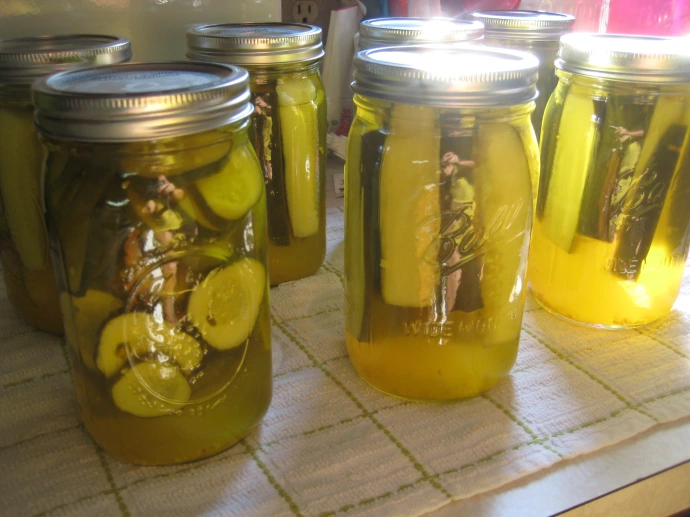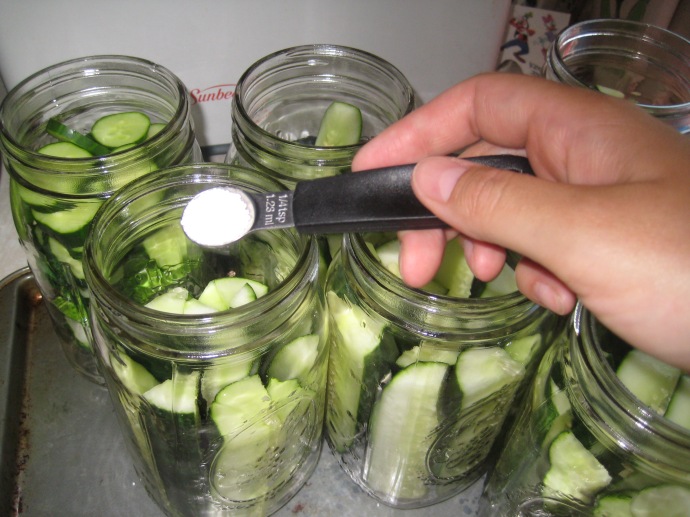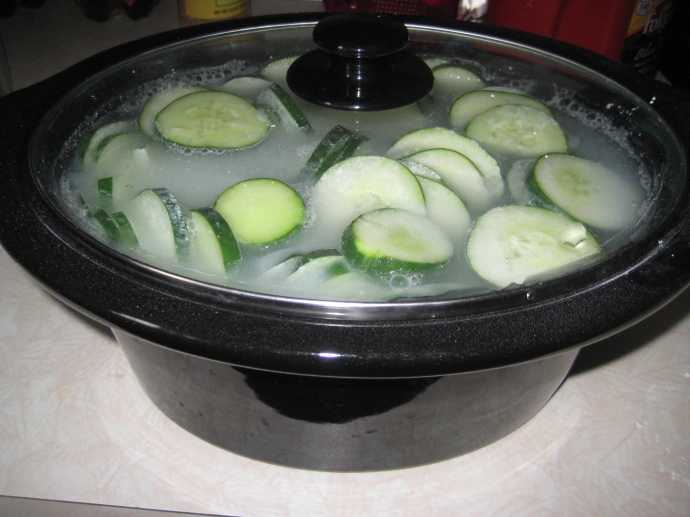I think in the future, looking back on this summer, I can probably call this “The Summer of Pickles”. I’ve made three different kinds of pickles this summer, mostly out of experimentation, and with the ultimate goal of achieving my heart’s desire: Vlasic, without the food coloring and preservatives. I’ve always been a Vlasic girl, and unfortunately, it looks like I’m going to continue to be one. I just cannot seem to nail down the right recipe! I tried Mrs. Wages dill mix, and the flavor is great, but the crunch is non-existent. I tried fermentation, and the crunch is decent and the flavor is unique and delicious, but it just isn’t Vlasic. The best pickle I’ve made so far, in fact, is the recipe for “Old South” pickles on the back of Mrs. Wages pickling lime mix. It’s basically a bread-and-butter pickle, but better. I love them, but I can’t promise my heart to them exclusively.
I’m not going to give up. I shall pursue my quest for a Vlasic copycat. And when I master it, you will be the first to know!
In the meantime, here are some tips for pickling cucumbers. I actually have not followed ALL these tips yet, which hopefully is why my pickles haven’t been super crunchy. The problem is that I’m growing my own pickling cucumbers, and I only get 2-3 ready at the same time, and I don’t really feel like putting all that effort into 2-3 pickles! I’ve decided NOT to grow my own pickling cucumbers next year, and instead order them in bulk from my local produce market owner. He told me that I can order them by size, which will be nice because then they will all be around the same size and ready for pickling at the same time!
Cucumber Tips:
- Use the cucumbers the day of or up to 24 hours of picking them (for the best crunch. You can certainly use them after that, but they won’t be as crunchy.)
- Do not wash the cucumbers until you are ready to use them! They start to deteriorate much quicker once washed.
- When making dill pickles, select pickles that are no longer than 6 inches.
- Cut 1/16 inch off each end of the cucumber. The blossom end contain enzymes that can cause soft pickles.
- Use only pickling cucumbers, the pickling brine will not be able to penetrate the wax coating on other cucumbers.
Brine Tips:
- Use only stainless steel or glass equipment. Other materials can react with the acid and alter the taste and color of the pickles. Especially do not use wooden spoons, they will absorb the flavor! (And, as a former Cutco salesgirl, I feel inclined to urge you to pitch all your wooden spoons and cutting boards. They are nasty and unsanitary! That is all.)
- Always use high-quality commercial white distilled or cider vinegar with 5% acidity unless other types are specified in the recipe.
- Use Pickling Salt instead of table or iodized salt, and use the correct amount called for in the recipe.
- Use only new dried spices, if using. Spices that have been on the shelf for over a year will not produce the best result.
- You need soft water to make pickles. If you only have hard water, you can soften your water by doing this: Bring hard water to a boil in a large stainless steel saucepan and boil for 15 minutes. Remove from heat, cover and let stand for 24 hours. Skim off any scum that has formed on the surface and carefully decant or ladle into another container, without disturbing the sediment that collects at the bottom.
(All tips were taken from the Ball Complete Book of Home Preserving)
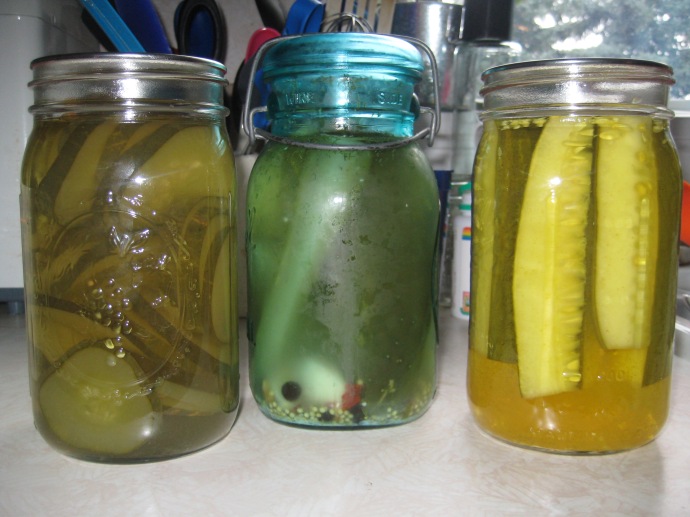
Old South on the Left, Refrigerator Pickles in the middle (How cool is that jar? I found 3 of those at a garage sale this summer!), and Mrs. Wages Dill mix on the right.
Here are a few recipes for you to experiment with:
I made the dill pickles with Mrs. Wages dill mix, which is pretty simple to do. I added Pickle Crisp, and can tell you that if you are a) not using pickling cucumbers, or b) not using freshly picked cucumbers, that even with the Pickle Crisp, you will NOT get crisp pickles.
Rather than write out a whole post on it, I will just direct you to the wonderful blog post I found for the refrigerator pickles. Recipe for fermentation-style refrigerator pickles
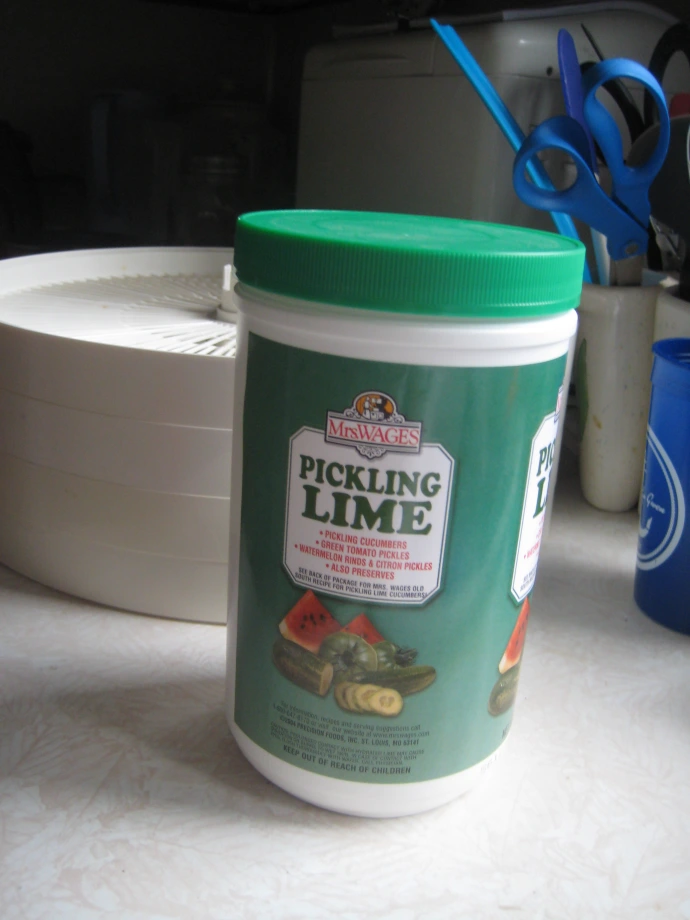
Doesn’t this jar look like something from the ’70s? I’m slightly concerned it actually might be, since I purchased it from a teeny tiny grocery store in a teeny tiny town. The mix YOU will be buying comes in 2012 packing;)
Old South Cucumber Lime Pickles
What you will need:
7 lbs cucumbers (sliced crosswise)
1 cup Mrs. Wages Pickling Lime
2 gallons water
8 cups white distilled vinegar, 5% acidity
8 cups sugar
1 Tbsp pickling salt
2 tsp mixed pickling spices
- Soak clean cucumbers in water and lime mixture in crockery or enamel ware for 2 hours or overnight. Do not use aluminum ware. (I used my two biggest crockpots)
- Remove sliced cucumbers from lime water. Discard lime water. Rinse 3 times in fresh cold water. Soak 3 hours in fresh ice water.
- Combine vinegar, sugar, salt and mixed pickling spices in a large pot. Bring to a low boil, stirring until sugar dissolves. Remove syrup from heat and add sliced cucumbers. Soak 5-6 hours or overnight.
- Boil the slices in the syrup 35 minutes. Fill sterilized jars with hot slices. Pour hot syrup over the slices, leaving 1/2 inch headspace. Cap each jar when filled.
- Process pints 10 minutes, quarts 15 minutes in a boiling water bath canner.
- Test jars for airtight seals according to manufacturer’s instructions.
(Recipe taken directly off the jar of Mrs. Wages Pickling Lime!)
The Old South pickles are pretty good! It is a labor-intensive recipe, but I really like them and think it is worth the effort. I will be making them again next year.
I’m still getting cucumbers out in my garden, so when I get around to it, here is The next pickle recipe I’m going to try!
Wish me luck! And good luck with your own!

